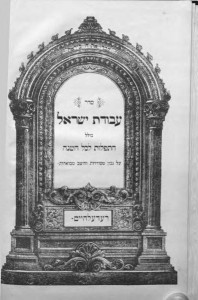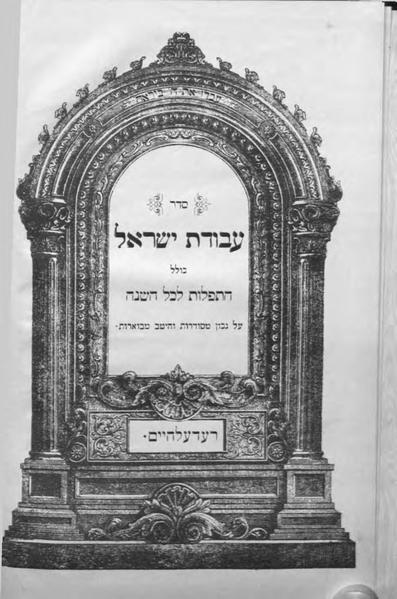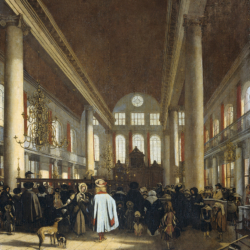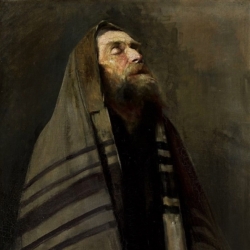Seder Avodat Yisroel was originally published in 1868 by the Rödelheim printing press. The edition we are transcribing is from 1901. Avodat Yisrael is respected as a carefully edited work. Its sources are cited in the introduction, and Baer’s commentary frequently explains his choice of text among the variants in his source manuscripts. Its text forms the basis for many of the 20th century’s Ashkenazic siddurim (including the Singer Siddur, whose translation we have already transcribed). Its extensive commentary is frequently quoted in academic studies of the Jewish liturgy.

Join us in creating a faithful digital transcription of the Seder Avodat Yisrael (Isaac Seligman Baer, 1868), a critical text of the nusaḥ Ashkeanaz.
Transcribing Seder Avodat Yisroel began in 2009 and continues today. In December 2009, we received transcription which Gabriel Wasserman transcribed for his Machzor l’Shabbat Hanukkah. Integrating Wasserman’s transcription into this transcription effort should save us some time.
After transcription and proofreading, this new digital edition will be shared under a Creative Commons Zero (CC0) Public Domain dedication. The edition will then be encoded in TEI XML and archived in the Open Siddur database, a libre Open Access liturgy database.
Skills necessary
To participate in this transcription project, you will need the following:
- basic literacy in the Hebrew/Ladino script popularized by Abraham Garton as “Rashi” script. Knowledge of Spanish is helpful
- typing with a Hebrew keyboard layout (see here for more information)
- registration in the collaborative transcription project, Hebrew Wikisource.

“סדר עבודת ישראל (אשכנז) | Seder Avodat Yisroel, a critical text of the Siddur annotated by Isaac Seligman Baer (1868)” is shared through the Open Siddur Project with a Creative Commons Public Domain Dedication 1.0 Universal license.







Thank you, Reuven. We’d love to include your English translation of Seder Avodat Yisroel. Would you consider sharing it with a Creative Commons, Attribution-ShareAlike license? Your work will remain copyright, but instead of “all rights reserved, the license explicitly grants permission to anyone to redistribute your work, allowing it to be incorporated into open source projects like the Open Siddur Project.
Congratulations on your efforts.
Siddur Avodas Yisroel, in large format, is in print and available in at least one bookshop in Bnei Brak, Israel (Lamdan – Beis HaSeforim, Rechov Kahaneman 64). A smaller, more compact format had been available up until about 15 years ago, but the demand for that was insufficient for reprinting. The price of the larger edition is around $20, but that is an approximation. Unlike the smaller version, it does not contain Tehillim nor the list of “Mizmorim” recited for each Parsha printed at the back. Close to 30 years ago, someone printed a separate Tehillim book from Baer, but not in the same format as that in the Siddur.
Baer was a great scholar and was involved in many printing projects. He, apparently, worked for the Roedelheim printers – successors to Wolf Heidenheim’s operation just outside of Frankfurt am Main, as well as a Hebrew teacher. He was involved in many printing efforts, even through the 1890s when he died. Avodas Yisroel has been his most lasting and best-known work, but he had many other notable publishing projects to his credit. Some of his works are now available in PDF form on the Internet, such as at Google Books, etc.
The great impact Siddur Avodas Yisroel has had cannot be underemphasized; albeit it not very well known among those who Daven “Nusach Sfard” and virtually unknown among Sephardim. But, SAY influenced many more modern Siddur publishers including the very popular Israeli Siddurim Tefilas Kol Peh of Eshkol and Rinas Yisroel by Rabbi Shlomo Tal, so the latter told me. I think that SAY has to be the most important “popular” Ashkenazi siddur published in the last few hundred years, albeit there the very detailed and punctilious Siddur of Reb Shabtai Sofer is preferred by non-German Ashkenazi purists for ultimate authenticity.
I have prepared the Mizmorim for the Sedras as a separate booklet and I have translated the the Halachic section at the beginning of SAY see http://www.613etc.com/inside.php?book=avodasyisroel&page=0. This is on my site http://www.613etc.com.
Best regards and good luck in your efforts,
Reuven Brauner
Thank you for the correction!
I’m specifically looking for the alternative prayers (to be said in the absence of a minyan) for Barekhu, Kiddusha, hatzi kaddish; I know they are included in this siddur. Can anyone help?
Hi. I am active at the Hebrew Wikisource, and recently began doing work in the area of liturgy. That is how I stumbled upon this wonderful “Open Siddur” website. I’m gratified and excited to see the wonderful work people are doing here!
People here may be interested in the following work I recently completed, and may find it helpful and useful for your excellent project here. The following are some link.
1. A Category at the Wikimedia Commons for scanned works of Wolf Heidenheim, including a full set of mahzorim and many editions of his siddur:
http://commons.wikimedia.org/wiki/Category:Wolf_Heidenheim
2. A Category at the Wikimedia Commons for scanned works of Seligman Baer, including two scans of Avodat Yisrael and one of Kinnot:
http://commons.wikimedia.org/wiki/Category:Seligman_Baer
3. Other Siddurim and Mahzorim:
http://commons.wikimedia.org/wiki/Category:Siddurim
http://commons.wikimedia.org/wiki/Category:Mahzorim
4. I’ve also begun working at the Hebrew Wikisource on the biblical text itself. I notice that here you use the Westminster text, but it needs to be corrected for the many times it (based on the Leningrad Codex) is at odds with the mesorah and with the many accurate Tanakhim in print today. My fully documented work on this is here, and already includes most of the megillot, half of Shemot, and the beginning of Vayikra:
http://he.wikisource.org/wiki/DOVI-TORAH
Any and all cooperation between these projects for the public good would be wonderful!
Shabbat Shalom and Purim Sameakh.
One last thing: Here is a new article I started yesterday on Seligman Baer. Feel free to add to it and improve it:
http://en.wikipedia.org/wiki/Seligman_Baer
Dovi,
We certainly should be cooperating and coordinating!
For what it’s worth, I’m collecting a library on Google Books of scanned public domain siddurim/machzorim.
A few questions:
(1) When you refer to cataloging differences between the WLC and the “mesorah,” which “mesorah” are you talking about (Rabbinic Bibles/Mikraot Gedolot? Extant parts of the Aleppo Codex? Reconstructed Aleppo Codex?)? I would like to incorporate the differences into our copy of the Tanach as well. In fact, handling variants is one of the main drives behind the design of our XML format, and why wiki technology is insufficient for our goals.
(2) I’ve been wary of copying scans from Hebrewbooks.org because many of them are low quality (making it hard to discern vowels) and they seem to be under the impression that their scans can be limited to non-commercial use, making them either non-free (although the theory on which it is based is dubious) or limited use by contractual agreement. Thoughts?
Hi, happy Purim (the craziness is beginning to end where I am)!
1. By the “mesorah” I mean exactly that: The system of Tiberian marginal notations meant to fix the letter-text of the bible. The accuracy of a manuscript was determined (in the eyes of the masoretes) by how well its text conformed to that system. There are a handful of Tiberian manuscripts that are considered extremely accurate because care was taken to correct their text according to that system, and the LC is one of the best of these: Its errors throughout the Tanakh number only in the hundreds, including about 120 in the Torah. Modern Torah scrolls are far better, however, because of generations of efforts to determine the mesorah and implement it within scrolls (as halakhah), and the result is that they conform almost exactly to the mesorah with the exception of 9 letters in Ashkenazic and Sephardic scrolls (and perfectly in Yemenite scrolls). Most good modern editions note these rare differences, but the WLC does not (since its only goal is to be an exact transcription of the LC).
Regarding the notation of differences, that is exactly my goal. I urge you to look at the underlying “edit” pages for the texts I have edited: The use of a simple template allows the wiki technology to be used for both a “clean” text and detailed notation of variants at the very same time. For the textual methodology I am using, see here:
http://he.wikisource.org/wiki/%D7%9E%D7%A9%D7%AA%D7%9E%D7%A9:Dovi/%D7%AA%D7%95%D7%A8%D7%94_%D7%A2%D7%9C_%D7%A4%D7%99_%D7%94%D7%9E%D7%A1%D7%95%D7%A8%D7%94/%D7%9E%D7%99%D7%93%D7%A2_%D7%A2%D7%9C_%D7%9E%D7%94%D7%93%D7%95%D7%A8%D7%94_%D7%96%D7%95
I’ve found HB scans to be satisfactory and extremely useful, but that may be because I think editing of vowelized text must be done by hand anyway. I’ve been in contact with Chaim Rosenberg several times and always found him to be extremely positive, supportive, and helpful. He fully realizes that most of his books are in the public domain, and the goal he often states is that he wants “to get the books out there” so that they can be used for good purposes. He also understands that Open Content projects like Wikisource (and by extension this project too) are volunteer projects not working for profit, and that their licences guarantee continued free use of the material. I suggest you contact him.
Regarding Google, they say something similar about non-commercial use, but that simply isn’t the law. However, I highly suggest using the Wikimedia Commons rather than Google for creating libraries or archives. First of all because the Commons has a completely open public process for periodic backups of their material, and Google of course doesn’t. Secondly because Google tends to close off public domain materials outside of the USA (even when local copyright law permits them). Some of the books in your Google Library of siddurim/mahzorim, for instance, are not available for download in Israel. Thirdly because Commons allows for collaborative organization and documentation of the material in a completely open fashion, and in multiple languages.
Happy Shushan Purim… the craziness just ended for me.
What you are doing is definitely a worthwhile project. I’m wondering if there’s any simple way to map the wiki text to the WLC XML. This may be better to discuss on the -tech email list than in the comments section here, though.
I’ve gotten mixed signals in my contacts with HB, and the scans I’ve found have been of varying quality. Some of them are pretty good, others (it might have happened that the ones I chose when I sampled were particularly low quality) made it difficult to discern the nikkud.
Is there any way to embed from Wikimedia commons, referencing a given page (image)? It’s one possibility I’ve been thinking of for our next-generation transcription tool so we would not have to store page images. I know it can be done with Google, which is what made me start looking at Google’s collections in the first place. Thanks for the heads-up, though, on Google locking down PD works outside the USA. If they are unavailable, then it really defeats the purpose of embedding from there. I was not aware of it. Again, better for discussion on -tech than here.
Have to run but briefly: Re-use by embedding from Wikimedia Commons is described here (for non-Wikimedia sites):
http://commons.wikimedia.org/wiki/Commons:First_steps/Reuse
For Wikimedia sites it’s even easier. If a certain is being heavily used, though, why not upload it?
Our goal is to move off MediaWiki completely into a transcription application that feeds directly into our database.
I’m not sure how heavily any given page will be used. During the process of transcription, each page will probably be looked at a few times by a transcriber and proofreader. After that, the page image only serves as a reference. Offsite storage of page images takes a lot of storage resources, at the cost of bandwidth (for both sides of the transaction).
Hebrewbooks.org solves the problem by degrading the page images to low-resolution and monochrome, which sometimes works and sometimes doesn’t when the goal is to transcribe with nikkud.
Incidentally, the reason we use 1 image per page is because we set up the wiki before ProofreadPage could handle multipage files.
What’s the status of this transcription project? I clicked trough to the wiki but it the transcription pages dont seem to work anymore. I myself cannot transcribe but I could proofread if there is work to be done. I’m working on preparing a friday night siddur for a small indepenant minyan whose members use varying nusachim and have varying familiarity with hebrew (Im including varients for Ashkenaz and Ari and a full transliteration). For that project, I’m particularly interested in getting at the text for Kabbalat Shabbat and Shabbat Arvit.
Thnaks, Amir
We’ve moved transcription over to Hebrew Wikisource. See here for the transcription landing page, and here for the discussion page with links to archived transcriptions of Seder Avodat Yisroel that need proofreading.
Is there a PDF of this book in one file? The file name and icon above appear to be a PDF but clicking it takes me to the he.wikisource transcription app where I can view individual pages but not download the whole thing.
Sorry for just seeing your question here Marc. Everything on Wikisource uses the Wikimedia Commons as its repository. The PDF online there is linked from here.
Since 2017, we began using the Internet Archive as our main repository for scanned files. Because the Wikimedia Commons sometimes required downsampling derivative versions of higher quality PDF images (due to size limits), we made this change. But there are still some PDFs I put together from early on that (as of today) only have the Wikimedia Commons as their repository.